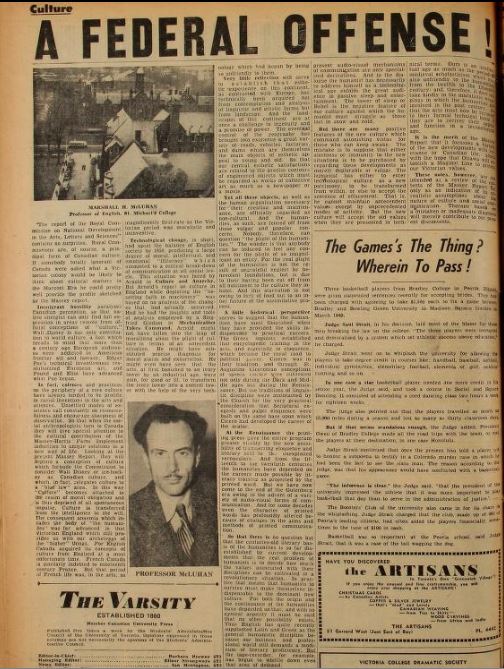In letters to Ezra Pound in July 1952 and to Walter Ong in January 1953,1 McLuhan wrote that he was working on a book titled ‘The End of the Gutenberg Era’.
In an earlier article in The Varsity,2, the University of Toronto student newspaper, McLuhan used the ‘end of the Gutenberg era’ phrase in December 1951, indicating that the project had already taken seed at that time:
At the Renaissance the printing press gave the entire [humanist] program greater vitality by the new possibility of transferring eloquence and literary skill to the unexploited vernaculars. And from the fifteenth to the twentieth centuries the humanities have depended on the careers made possible by literary training as projected by the printed word. But we have now come to the end of the Gutenberg era owing to the advent of a variety of audio-visual forms of communication. (…) So that there is no question but that the centuries-old literary basis of the humanities is so far disestablished by current developments that the real problem of humanists is to decide how much the values associated with their disciplines can be cultivated in a revolutionary situation.
In the same article he referred to “the Marconi era”3 as if it were part of his original idea to juxtapose ‘eras’. Indeed, six years later, these two eras were still on his mind:
Of course, had we had any awareness of the psycho-dynamics of our Gutenberg era before it began to yield to the Marconi era we would have been less surprised and much better able to effect a proper transition to the new culture without total jettisoning of the educational and social values of print and lineality. Instead of understanding these matters we have tended to substitute moral denunciation and recrimination, alarm and complacency. (Explorations 8, 1957)
The crucial problem that McLuhan had with this conception of successive eras has bedeviled scholarship on his work ever since. Namely, serial order of one-thing-after-another — the printed line, the assembly line, the rail line — is an essential characteristic of the Gutenberg galaxy: as McLuhan said in Explorations 8, this galaxy was just the expression of “the educational and social values of print and lineality“. To describe the relationship of eras as a chronological series was therefore to install that galaxy as basic to the order of all possible galaxies, each one coming after a previous one, like moments in time or numbers in sequence. But the assertion of this ultimately ontological claim is just what the “Gutenberg galaxy” was — and is! To suggest that it might be “coming to the end of its era” was, therefore, actually only to extend its dominion immeasurably! Beyond its end!
At the start of 1952 McLuhan had a knot of central problems to solve: how to come loose from the Gutenberg era at all? how come loose from it in a way that was not simply subsequent and oppositional?4 how come loose from it but ‘at the same time’ preserve important values from it?
At this time McLuhan was already underway to his first article in Explorations, ‘Culture Without Literacy’ (1953) and, ultimately, a decade in the future, to The Gutenberg Galaxy and Understanding Media:
When we juxtapose news items from Tokyo, London, New York, Chile, Africa and New Zealand we are not just manipulating space. The events so brought together [in the news] belong to cultures widely separated in time. The modern world abridges all historical times as readily as it reduces space. Everywhere and every age have become here and now. History has been abolished by our new media. If prehistoric man is simply preliterate man living in a timeless world of seasonal recurrence, may not posthistoric man find himself in a similar situation? May not the upshot of our technology be the awakening from the historically conditioned [= Gutenberg] nightmare of the past into a timeless present? Historic man [situated between the prehistoric and the posthistoric] may turn out to have been literate man. An episode. (Culture Without Literacy, Explorations 1)
But if “the upshot of our technology [may] be the awakening from the historically conditioned nightmare of the past into a timeless present”, when would these variations on time, these “eras” or “episodes”, have been? Or, indeed, be?
The mechanical clock (…) created a wholly artificial image of time as a uniform linear structure. This artificial form gradually changed habits of work, feeling and thought which are only being rejected today.5 We know that in our own lives each event exists in its own time. (…) Ultimately the medieval clock made Newtonian physics possible. It may also have initiated those orderly linear habits which made possible the rectilinear page of print created from movable type, as well as the methods of commerce. (Culture Without Literacy, Explorations 1)
- See The Beginnings of Gutenberg Galaxy 1. ↩
- ‘A Federal Offense!’, The Varsity, 71:55, p 8, December 17, 1951. See A Federal Offense! ↩
- “If somebody totally ignorant Canada were asked what a Victorian colony would be likely to think about cultural matter, in the Marconi Era, he could pretty well provide the profile sketched by the Massey report.” ↩
- Unmediated opposition was another characteristic of the Gutenberg galaxy along with serial order. Indeed, the two would seem to imply each other. But how then account for its other central characteristic — ‘continuity’? The twentieth century gnawed on these problems across many fields from music to linguistics to physics — and McLuhan’s enterprise must be understood in this ‘being and time’ context. ↩
- With the placement of the word ‘only’ here, did McLuhan mean that these habits were meeting ‘only’ rejection today or that it was ‘only’ today that they were finally meeting rejection? ↩

